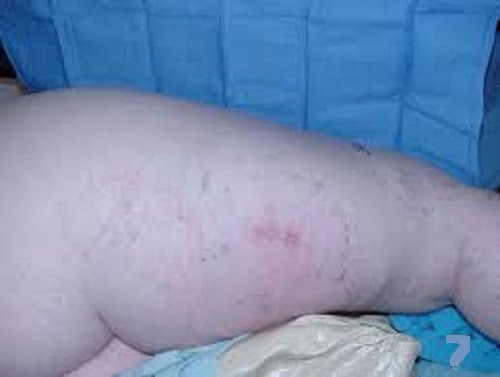The fibrous tumor is also known as solitary fibrous tumor. It is a rare growth of soft tissue cells which can form nearly anywhere in the body. It begins in the tissue which connects, support and surrounds other body structures. This is including muscle, fat, blood vessels, nerves, tendons and the lining of the joints. It is known that more than 50 types of fibrous tumors exist. There are some types which more likely affect the children, while others affect mostly adults.
It is noticed that these tumors can be difficult to diagnose because they can be mistaken for many other types of growths. The fibrous tumor can happen anywhere in the body, but most common types happen in the arms and legs and in the abdomen. It is known that the surgical removal is the most common treatment [1], but the radiation and chemotherapy also may be recommended, depending on the location, type, size and aggressiveness of the tumor.

Fibrous tumor symptoms
The fibrous tumor may not cause any signs and symptoms in its early stages, but as the tumor grows, it can cause:
- Pain, if the tumor presses on nerves or muscles
- A noticeable lump or swelling
You should talk with your doctor if you have recurrence of a lump that has been removed; a lump of any size that is located deep within a muscle or a lump that is increasing in size or becomes painful [2]. There are so many different types of fibrous tumor, so it is very important for your doctor to determine the exact nature of each tumor, so he or she can give you the best treatment.
The treatment option will depend on the size, type and location of your tumor. Surgery is a very common treatment for the fibrous tumor. Generally, surgery is involving removing the cancer and some healthy tissue which are surrounding it [1]. If you have fibrous tumor, then you should not be ashamed to talk with your doctor about your condition. It is very important to have support from your family and friends too. Some imaging tests which your doctor can make include PET (positron emission tomography); MRI (magnetic resonance imaging); CT (computerized tomography); ultrasound, X – rays.
Also, your doctor may remove a small piece of tissue for examination under a microscope to confirm a suspected fibrous tumor. This is process which is known as biopsy. The experienced pathologist can confirm the diagnosis and he or she can determine whether the tumor is cancerous or not. Your doctor can give you some medications which can help in the treatment of fibrous tumor.
Fibrous tumor causes
In many cases, the cause for fibrous tumor is not known. In the most cases, cancers happen when cells develop mutations (errors) in their DNA [3]. These errors make cell grow and divide out of control. The accumulating abnormal cells are forming a tumor which can grow to invade nearby structures and the abnormal cells can spread to other parts of the body. The type of the cell which develops the genetic mutation determines what the type of fibrous tumor you have. For example, the liposarcoma arises from fat cells while the angiosarcoma begins in the lining of the blood vessels.
Types
Some types of fibrous tumor include:
- Synovial sarcoma
- Solitary fibrous tumor
- Rhabdomyosarcoma
- Myxofibrosarcoma
- Malignant peripheral nerve sheath tumor
- Liposarcoma
- Leiomyosarcoma
- Kaposi’s sarcoma
- Gastrointestinal stromatol tumor
- Epithelioid sarcoma
- Dermatofibrosarcoma protuberans
- Angiosarcoma
Risk factors
There are some factors which can increase the risk of tumor, such as
- Radiation exposure: It is noticed that the previous radiation treatment for other cancers can increase the risk for tumor. [4]
- Chemical exposure: If you are exposed to certain chemicals, such as dioxin, arsenic and herbicides and it can increase the risk of soft tissue sarcomas. [5]
- Inherited syndromes: The risk of tumor can be inherited from the parents. The genetic syndrome which is increasing the risk is including hereditary retinoblastoma, Werner syndrome, tuberous sclerosis, neurofibromatosis, familial adenomatous polyposis and Li – Fraumeni syndrome. [6]
References:
[1] Wang Y, Wei R, Ji T, et al. Surgical treatment of primary solitary fibrous tumors involving the pelvic ring. PLoS One. 2018;13(11):e0207581.
[2] Gao C, Zhang Y, Li YY, et al. Postoperative recurrence solitary fibrous tumor of the pelvic with malignant transformation. International Journal of Clinical and Experimental Medicine. 2015;8(9):16827–33.
[3] Kaiser J. Massive cancer genome study reveals how DNA errors drive tumor growth. Science. 2020. Retrieved from www.sciencemag.org/news/2020/02/massive-cancer-genome-study-reveals-how-dna-errors-drive-tumor-growth
[4] Rana N, Kim E, Jaboin J, Attia A. The role of adjuvant radiation in the management of solitary fibrous tumors of the central nervous system: A national cancer database analysis of 155 patients. Cureus. 2018;10(5):e2656.
[5] Tuomisto JT, Pekkanen J, Kiviranta H, et al. Soft‐tissue sarcoma and dioxin: A case‐control study. International Journal of Cancer. 2004;108(6):893-900.
[6] Postow MA, Robson ME. Inherited gastrointestinal stromal tumor syndromes: mutations, clinical features, and therapeutic implications. Clinical Sarcoma Research. 2012;2:16.




